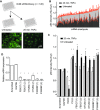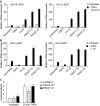Identification of F-box only protein 7 as a negative regulator of NF-kappaB signalling
- PMID: 22212761
- PMCID: PMC3822984
- DOI: 10.1111/j.1582-4934.2012.01524.x
Identification of F-box only protein 7 as a negative regulator of NF-kappaB signalling
Abstract
The nuclear factor κB (NF-κB) signalling pathway controls important cellular events such as cell proliferation, differentiation, apoptosis and immune responses. Pathway activation occurs rapidly upon TNFα stimulation and is highly dependent on ubiquitination events. Using cytoplasmic to nuclear translocation of the NF-κB transcription factor family member p65 as a read-out, we screened a synthetic siRNA library targeting enzymes involved in ubiquitin conjugation and de-conjugation for modifiers of regulatory ubiquitination events in NF-κB signalling. We identified F-box protein only 7 (FBXO7), a component of Skp, Cullin, F-box (SCF)-ubiquitin ligase complexes, as a negative regulator of NF-κB signalling. F-box protein only 7 binds to, and mediates ubiquitin conjugation to cIAP1 and TRAF2, resulting in decreased RIP1 ubiquitination and lowered NF-κB signalling activity.
© 2012 The Authors Journal of Cellular and Molecular Medicine © 2012 Foundation for Cellular and Molecular Medicine/Blackwell Publishing Ltd.
Figures





References
-
- Chen G, Goeddel DV. TNF-R1 signaling: a beautiful pathway. Science. 2002;296:1634–5. - PubMed
-
- Karin M, Cao Y, Greten FR, et al. NF-kappaB in cancer: from innocent bystander to major culprit. Nat Rev Cancer. 2002;2:301–10. - PubMed
-
- Wajant H, Scheurich P. TNFR1-induced activation of the classical NF-kappaB pathway. FEBS J. 2011;278:862–76. - PubMed
Publication types
MeSH terms
Substances
Grants and funding
LinkOut - more resources
Full Text Sources
Molecular Biology Databases
Miscellaneous

